Kashmir’s history’s oldest tool against harshest winters has not evolved as a symbol of culture alone but a roaring business as well. Evaluating the supply-demand matrix of Kashmir’s celebrated fire-pot, Minhaj Masoodi visited the people behind the chain of complicated processes that helped the endemic device survive against all odds
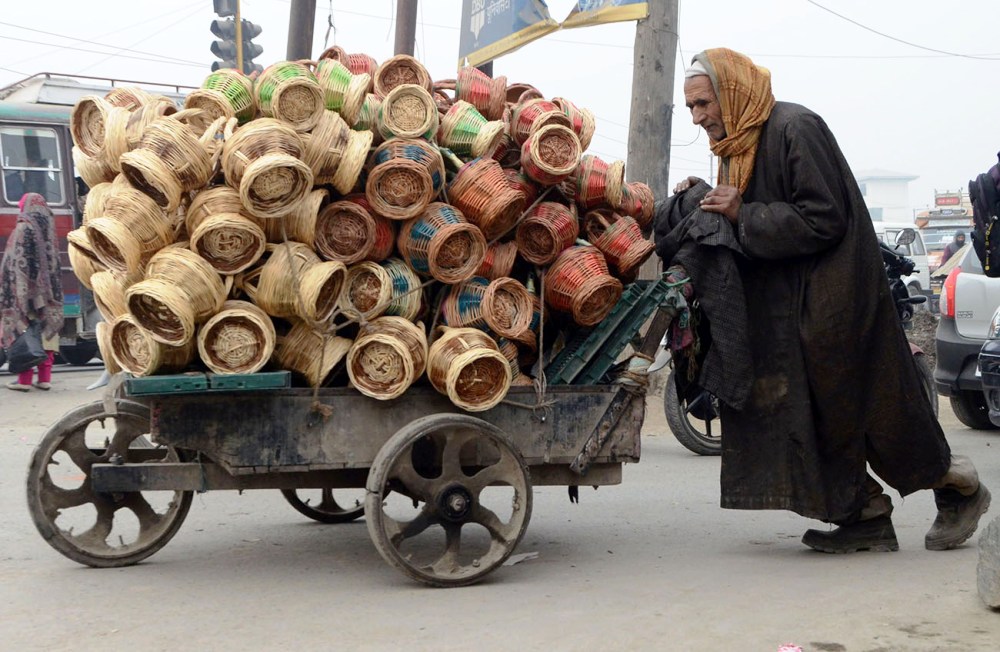
Every day, braving chilly weather in the morning, Mohammad Yusuf Malla sets off from his home in north Kashmir’s Pattan to head to Srinagar. Malla owns a Kangri shop at Batamaloo, the erstwhile bus stand and a melting pot of a multitude of Kashmir subcultures. He has quite a few vendors waiting outside his shop, who buy Kangris from him and set off to different city areas to sell the portable firepot, which in absence of proper electricity supply is the last hope for many from getting cold feet due to Kashmir’s frigid temperatures.
An indispensable part of a Kashmiri’s life during winters, Kangris have been a source of comfort and warmth since time immemorial. While the rich and powerful migrate to the plains in winters to their second homes, the ordinary Kashmiri has only a portable ember laden fire pot to keep himself warm in the bone-chilling cold.
This earthen pot carrying the burning charcoal and carried under the long loose cloak, the Pheran has been an interesting subject for all the people who have visited Kashmir for centuries. Off late, the Kangri is in use during winters everywhere Kashmiris visit during winters. Kashmiri Pandits who migrated out of the valley in 1990 use it in Delhi, Jammu, Shimla and Punjab. In most of the fruit mandis where Kashmir’s apple growers go during winters’ Kangri is visible. Jammu alone is consuming almost 40,000 pieces of Kangri, a year.
Though the nay-sayers have been writing Kangri’s obituary for a long time, especially after modern gadgetry become trendy and the prosperity led to the mass use of Hamams, the fire-pot continues to survive as small economic activity. The Kangri pyramid has an extensive network of materials, processes and artisans who keep the warmth flowing under the Kashmir Pherans.
Laborious Process
Sourcing warmth from the Kangri is the easy part. Put some coals, fire them up and voila! You have a portable source to ensure a non-stop source of warmth to last an entire day. However, the process of making Kangri is very cumbersome and labour intensive. The whole process goes through many stages before the Kangri hits the market in the colourful sunny autumns.
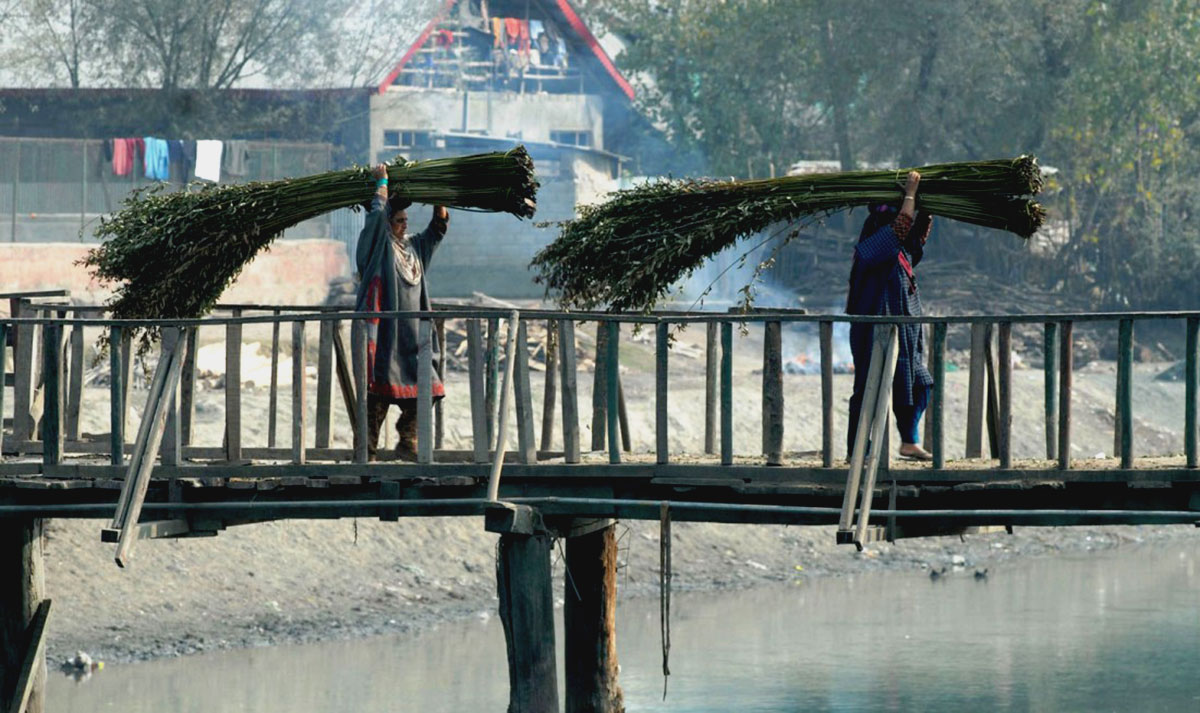
Malla says that there’s a chain of people involved in making a Kangri. It starts with harvesting the twigs, treating them in order to make them Kangri-ready, the earthen pot called Kondal in local parlance, which holds the coals around which the weavers weave the Kangris.
Harvesting Kanis
Kani (Twigs) are usually harvested from Willows. Traditionally, they used to be available in the wild but due to large scale demand, they are now being cultivated in nurseries dedicated only for their production.
Bilal Dar harvests willow twigs for Kangris in nurseries in Ganderbal’s Shallabug area. “These willows are basically grown on special lands, from where they are then harvested twice a year,” Dar said. “Once in autumn and in spring, although primarily during the autumn.”
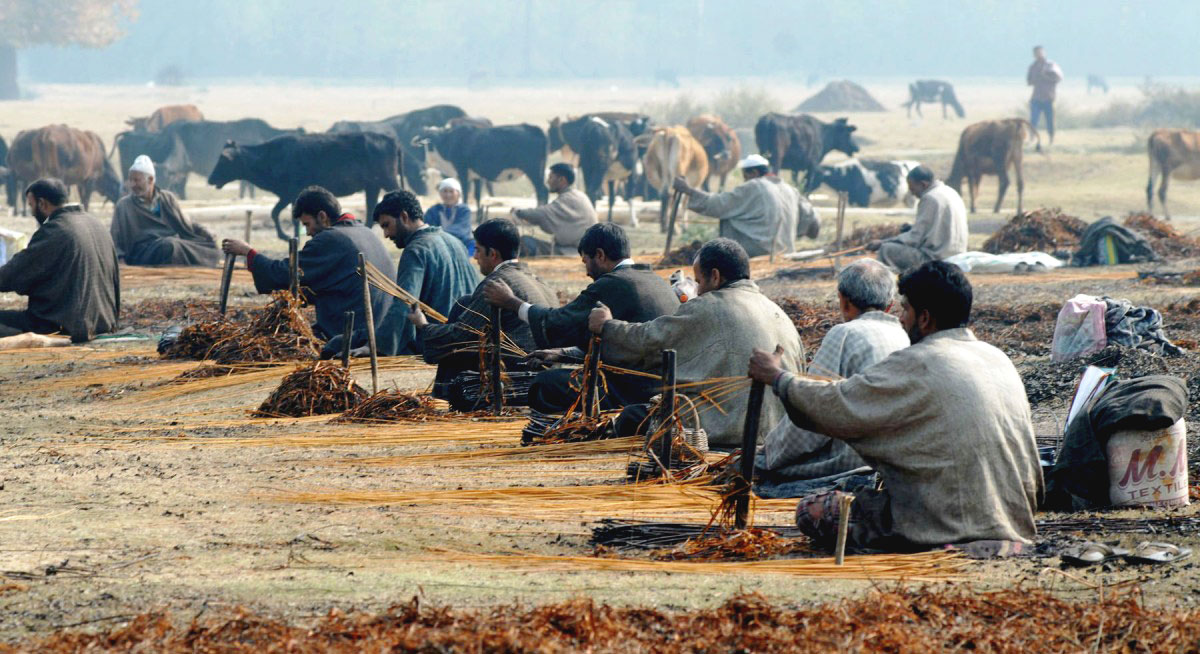
Like other cash crops, Kani cultivation is laborious and technical. Generally, during early spring, beds are made for their cultivation by digging pits of 3 feet depth. Then, saplings, which measure anywhere between 9 to 12 inches are planted in straight lines with a gap of 1 to 1.5 feet. The plant grows shoots on all sides which go multiplying over the years until they take the form of a bush.
The plant takes about a year to grow about 4 feet tall after which it is then cut from the ground itself leaving only roots under the ground. Next year, the plant again grows at the same spot during the subsequent years and attains an average height of 10 to 12 feet with an average life span of 8 to 10 years. However, the old roots are extracted permanently and are used as firewood.
As per Bilal’s estimation, one kanal of land yields around 20-30 Mann of twigs. Mann, a traditional measure for weight is around 40 kilograms. Two and a half mann constitute a quintal. “About, 10-11 quintals of twigs, per kanaal” Bilal said. Raw Mann sells anywhere between Rs 400-550.
Processing
Twig-cultivators are the supplies of basic material. It is taken over by a different set of professionals.
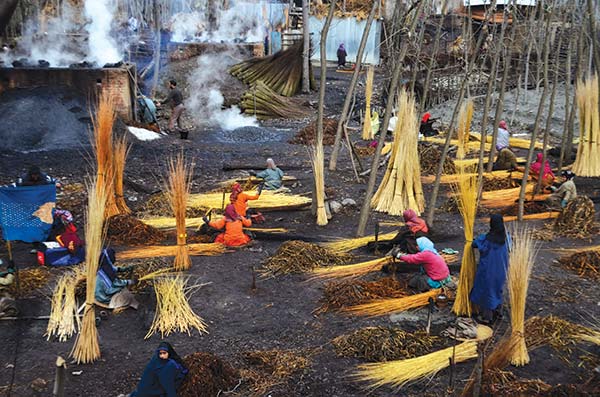
Twigs are harvested when they are still raw and put in boilers for them to soften. The boiler is made of iron measuring 10-12 ft in length about 4 feet in-breath and is about 4-5 feet deep. The boiler is installed on a plinth of burnt bricks above three feet from the ground and depending on size, it is filled with about 50-100 gallons of water. At a time, 20-30 manns of twigs are put in the boiler, once the water reaches the boiling point. About 30-40 kgs of firewood are consumed in the process. The twigs are covered with heavy stones and allowed to boil for at least six hours.
After the boiling treatment, the twigs are extracted from the boilers and the peeling of the skin takes place. The peeling of the twigs is a complicated process. The processors have devised a simple mechanism that helps them peel the twig skin.
The twigs are cleaned, segregated and cut to size based on their thinness. The thinner the twig, the more is the price.
“We have boilers set up at the peripheries of the Shallabug wetland where we boil them in order to make them soft, after which we sell them to the weavers,” Bilal said.
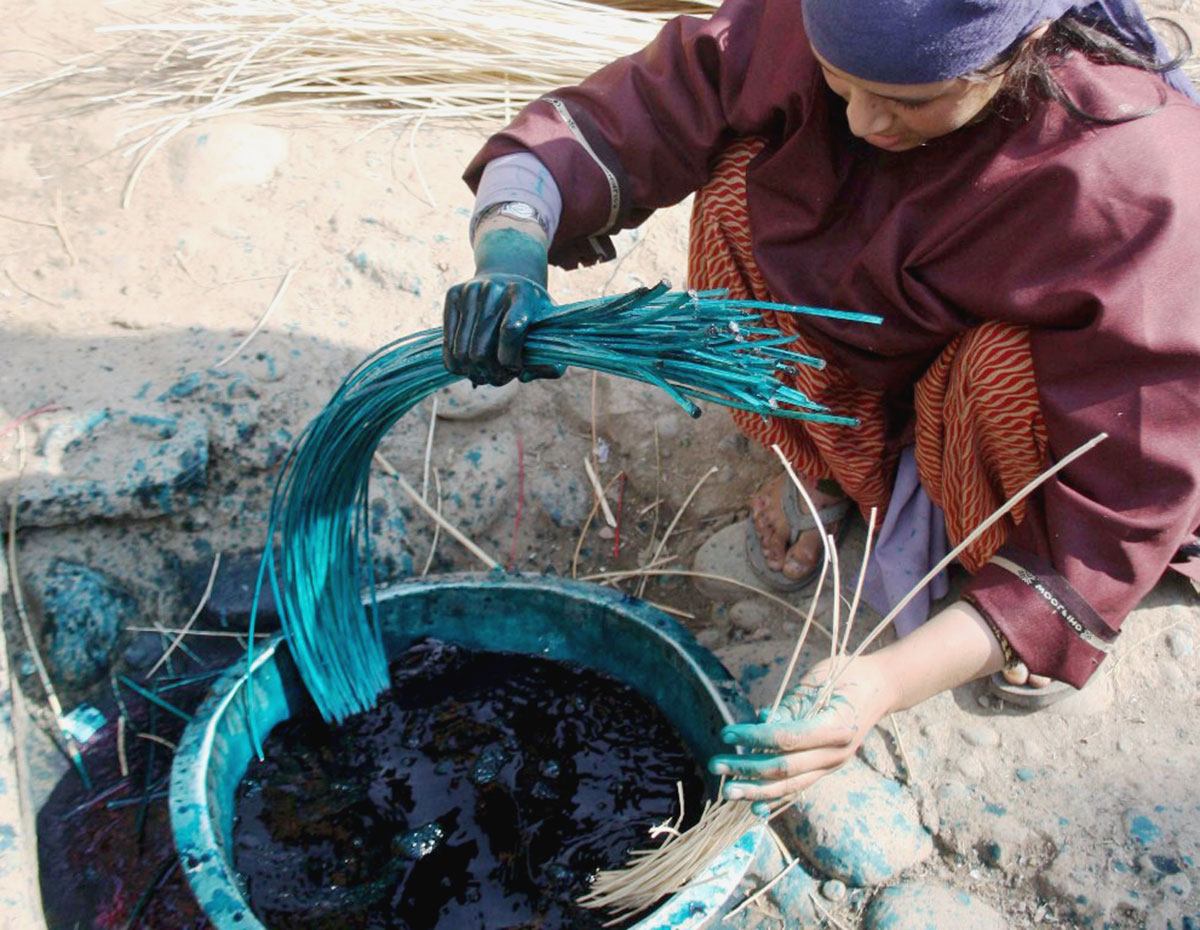
Shallabug and its adjoining areas produce the bulk of the twigs required for Kangri weaving and other wicker works. “It is cultivated mainly in Ganderbal’s five villages; Shallabug, Hakeem Gund, Kujar, Harran, Kachan,” Bilal said.
Dar estimated the harvested produce to be in upwards of Rs 40 lakh being cultivated in the area alone. “There are other places also who cultivate willow twigs. Shallabug alone must be producing twigs worth Rs 40-45 lakh.”
Aaqib Hussain, an independent researcher who has worked on the willow wicker production, said that there are a number of willow species from which the twigs are sourced. Each has its own use. There’s Salix Alba, the white willow. It is humungous in size. It has a subspecies, Cornelia, from which cricket bats are made. Then there is Salix Tetrasperma. It is used especially to make Kangris.”
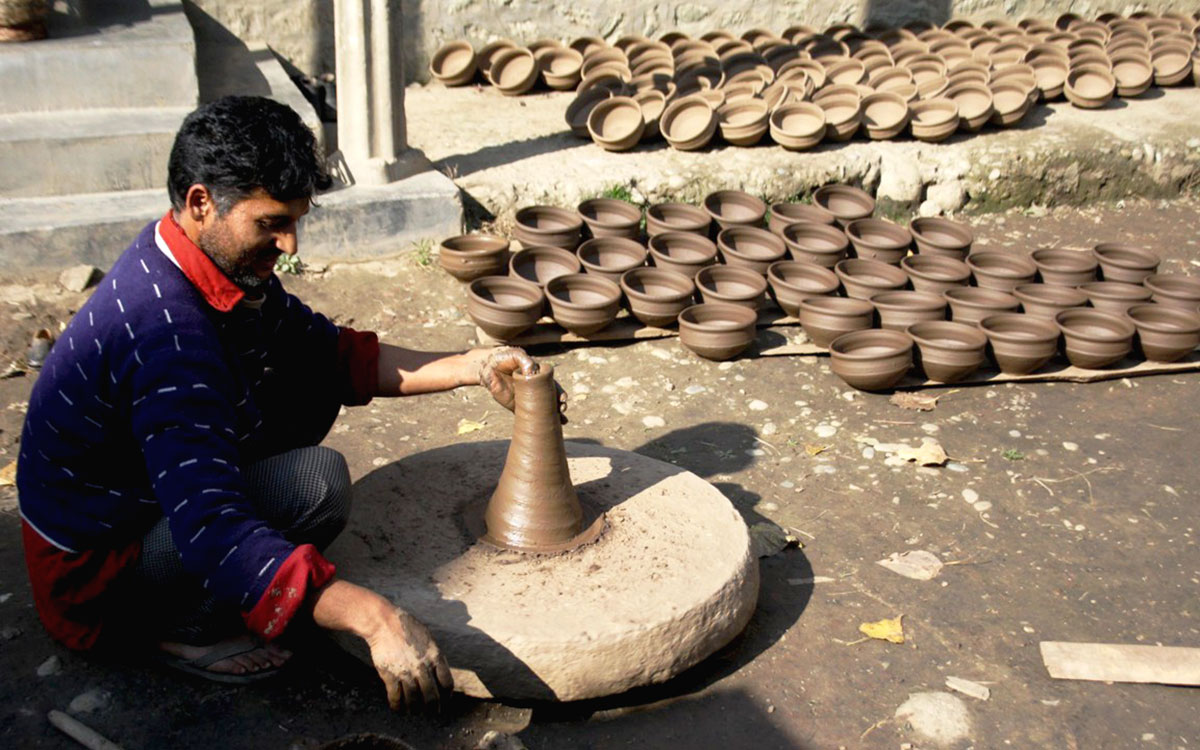
He said that Poash Kaen is Tetrasperma. “It is reddish in nature. While the Keczh Kaen is Indigofera. Keczh is usually used for not so sturdy ones,” Hussain said. “There are basically three to four subtypes of Tetrasperma which are distinguished on the basis of colour, flexibility and sturdiness. They are basically cut at different stages. If you cut it at a young age, in its silvicultural cycle, you get more flexibility in the twig. If strength and durability is needed, then they are cut at a later stage.”
He said that it depends on what stage these twigs are cut to impart various properties to them. However, he added that the preference of the Poash Kaen to be used in the Kangris is because of its capacity to bear the shear and stress load of the shrub. “And it also has good bending capacity.”
“There are a lot of people who cultivate it now in nurseries, around Dargah and Shallabug, in Ganderbal, which is particularly famous for it. This willow requires marshy habitat to grow which explains why it is grown in and around Shallabug because it has a wetland in its vicinity.”
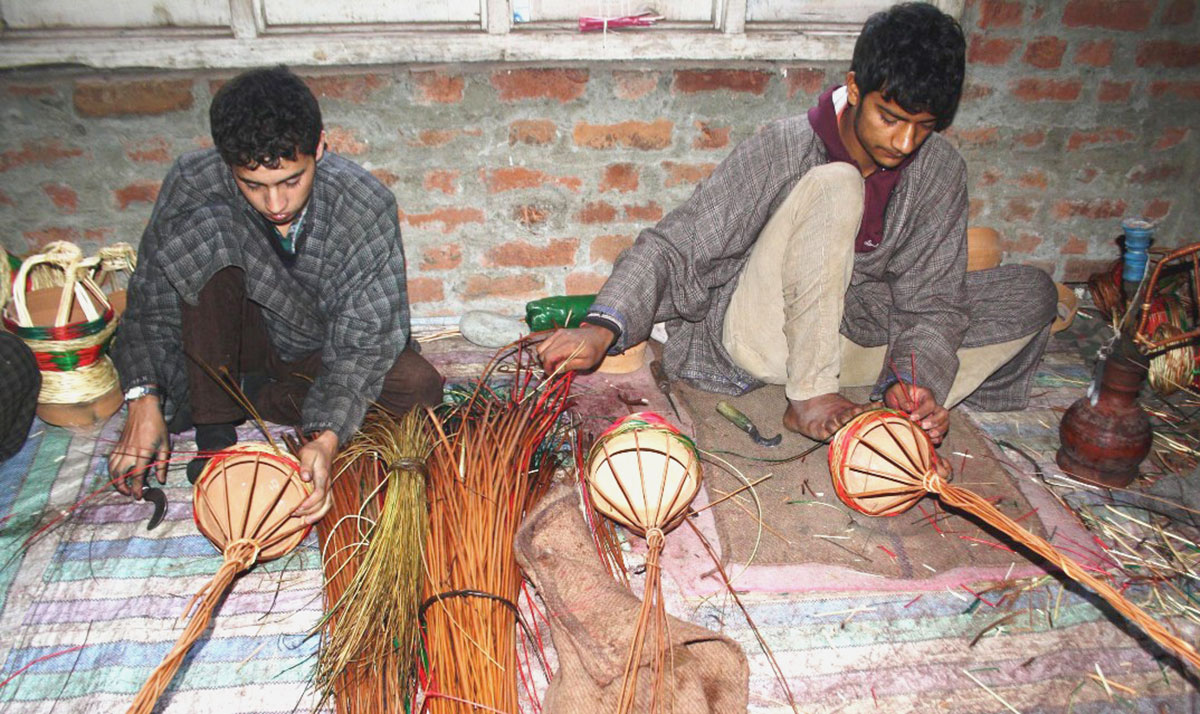
SKUAST Study
In earlier times, a large part of the twig produce was sourced from the forests. A study done by SKUAST-Wadura in 2015 in Pulwama district regarding the status of wicker collection found that the total collection of wickers from different sources in the surveyed population was found to be 61.71 tons per annum. Out of the total extraction, 91.72 per cent was secured from forests and the rest (8.37 per cent ) from agro-forestry and homestead forestry. The shrub is called Hatab (Parrotiopsis). Its seed, although very small, is eaten by Hangul and the enzymatic action in its digestive system dissolves its outer coat to facilitate its germination.
Dr Aaqib, however, said that its main source of propagation now is through layering.
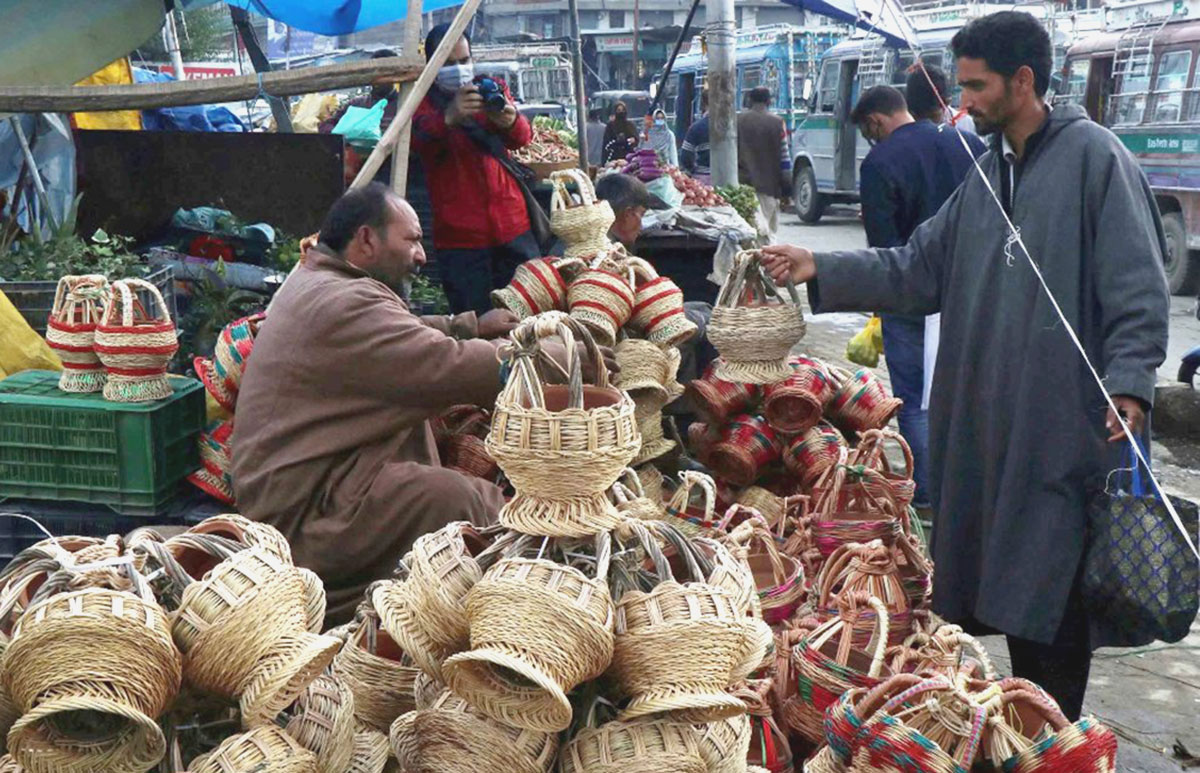
The Weaving Process
Although Kangri weaving is done all over Kashmir, certain areas have the core concentration of Kangri weavers. Among them, Bandipora, Charar and Wokai in Kulgam are usually being referred as the key weaving spots.
Once the twigs are ready, they are sold to weavers for manufacturing the Kangri. Mohammad Yaqoob, a Kangri weaver from Wokai, Kulgam has been in the profession for the last many decades. His village has almost 900 households. Yaqoob said, over 800 of them are directly associated with the Kangri making.
“Each worker makes about 1200-1500 Kangris a season. The total number must be in lakhs.”
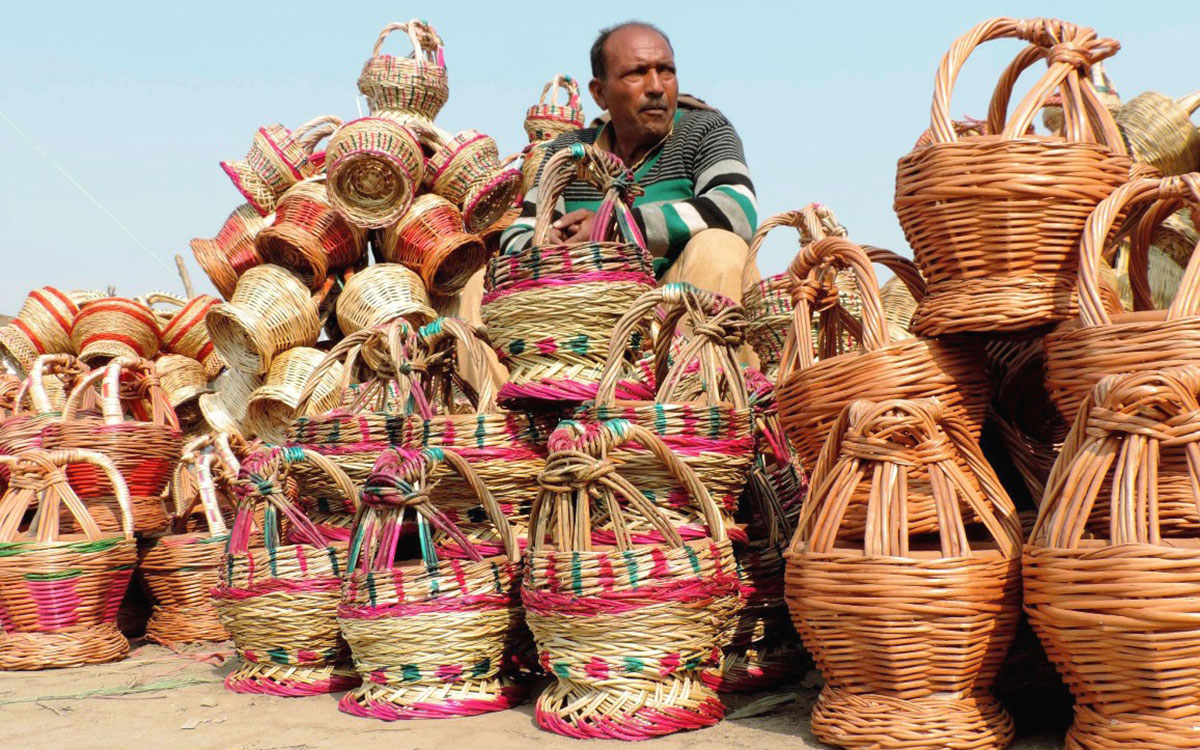
In a Handicraft Survey on Kangri and Willow Wicket Basketry based on a 1981 census report, Wokai was suggested having 230 households engaged in the craft of willow weaving. The report said that they had taken to craft practice on a non-traditional basis but few belonging to the Shaaksaaz community had been practising the craft for generations.
The number has significantly gone up since so much so, the Kangri weaving has become the mainstay of their economy. Unlike many other centres, Wokai sustains itself on wicker and Kangri weaving throughout the year. This is their primary craft. “We do it all through the year. This is our sole source of sustenance for the majority of us in the village,” Yaqoob said.
Yaqoob said they source the material in and around their own village area. However, if they fall short of the twigs, they get it from Ganderbal. “They have very fertile lands for growing these twigs. The harvested twigs are put in boilers and softened. They are then dried, till they get a reddish tinge. We get Safed (White) twigs from Noorabad, here in south Kashmir.”
He said that an average worker gets twigs worth one lakh rupees per season. “By the end, he has earned over Rs 60,000-70,000 profit, mostly his input by way of weaving it.”
Bandpoer Kanger
Kangris made in and around Ajas belt in Bandipora in north Kashmir are also famous. Aadil Ahmad Ganaie, another Kangri weaver from Kaloosa area of Bandipora said, Kangris come in five-six types. “There is Single, Double, Abaya Base, 12, 14, 16, 20 Pohur (strand) and so on.” He said the more the number of strands, the better the build quality, and the more expensive the Kangri is.

He said that the twigs normally used by them are Keczh Kaen (Twig), Poash Kaen (Twig), and Poher Kaen (Twig). “We get Keczh from Kangan, Ganderbal and Tangmarg and Choontmulla, in Bandipora.”
Aadil said that Kangri built from Poash twig remains very sturdy. “That Kangri is actually known as Bandpoer Kanger.” Poash Kaen gets its sturdiness from sun drying and it also lasts longer, he said.
However, he said that the original Bandpoer Kanger is not made these days. “We get orders around June or July. We get a budget from traders, which normally hovers around Rs 150 per Kangri. In that amount, we make normal and average stuff Kangris. It depends on the budget and order we get from traders. Basically, demand in the market dictates the quality and quantity of, Kangris they want us to make,” he said.
Industry Worth
Adil’s estimations put the number of Kangris produced each year in between 10-12 lakh. Thousands are repaired every year too. For repairs though, they use Poher and Poash Kaen. Low production of the firepot is linked to the durability of the stuff in a season. By and large, a Kangri purchased a year will last for two seasons and if possible it can be repaired to survive in the third season as well. Although, liberal estimates put the figure in the vicinity of 2 million per year. If these estimates are anything to go by, Kangris worth Rs 75-100 crore are manufactured every year in the valley.
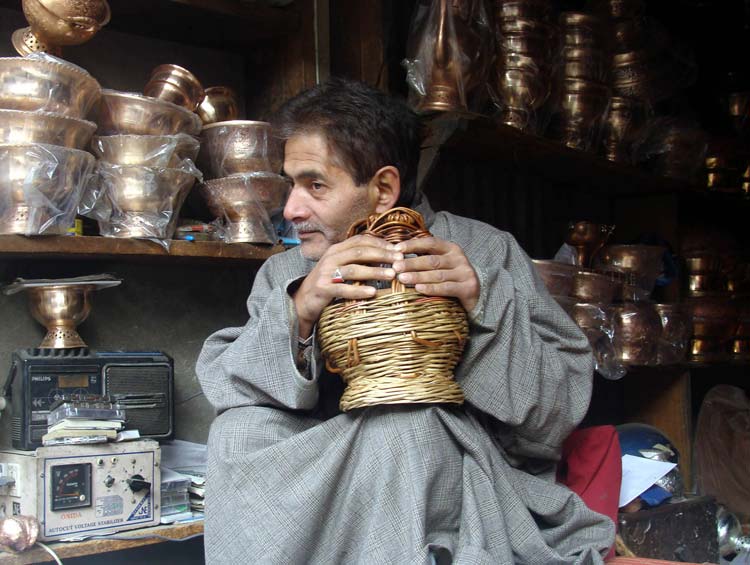
It does not, however, include the costs involving the raw material that Kangris consume. There are different kinds of charcoal that go into its use and it runs in much more than the Kangri turnover.
Adil himself weaves around 800-1000 Kangris per season. However, over time, cost escalations have dampened the demand as well as production. “We used to get twigs from Kangan, earlier. But the check posts at Kangan, charge us Rs 10-12000 for letting us transport the twigs to Bandipora. What would otherwise cost Rs 450-500 rupees, quintal, costs Rs 1200-1300.”
However, unlike Yaqoob, Aadil does not make Kangris all year round. He only does it during the winter months when the demand is high. For the rest of the year, they make other wicker products such as baskets, and other import quality products. “Kangri has a domestic market and its peak demand is in winters. During the rest of the year, we make wicker based decorative items as well.”
Charar, another hub of Kangri makers, as per conservative estimates produces around 60,000 Kangris, a year while some reports say the number stretches as far as two hundred thousand a season.
Kondal Making
However, before the weaver sets about making Kangris they require pots around which the wickerwork is done. Although potters do all kinds of pottery, many are now devoting themselves entirely to Kondal making. In the historical Gufkral village in south Kashmir’s Tral, Muzaffar is a fourth-generation potter who specializes only in making the Kondals for Kangris.
Traditionally, people used to only carry Kondal with charcoal embers in it during the winter. However, as design intricacies continued to develop, artisans started to weave wicker around the earthen pots.
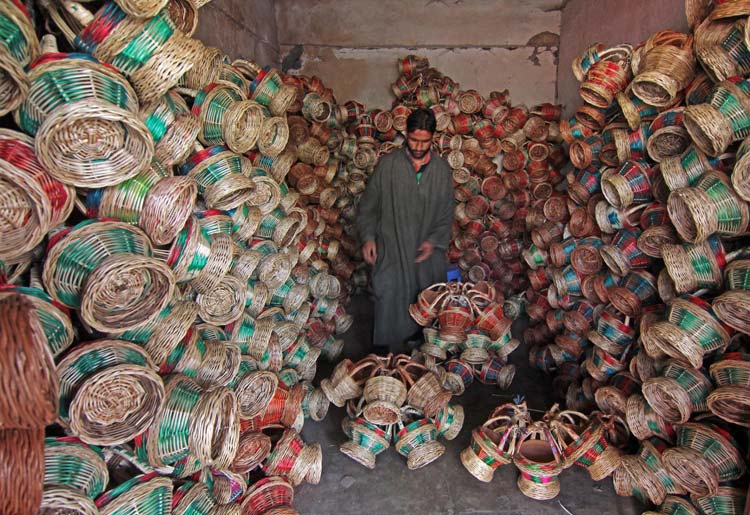
In a season, Muzaffar makes about 10,000 of them in a season. There are seven other households in his villages who concern themselves with only Kondal making. He estimated, together they make about a hundred thousand a season.
“Kondal as per current market prices fetches around Rs 12 apiece,” said Muzaffar. They are usually of the same size, but sometimes we get special orders to make a particular size. Otherwise, it is all uniform.”
The mismatch between the numbers of the Kundals and the kangris is because the earthen pot usually survives the hot charcoals instead of the wicker basket it is in.
The Kangri market would offer some role to the carpenters and the blacksmiths who would make wooden or metallic Tchalan, a spatula type thing hanging with the Kangri It is used to manage the hot charcoals better.
Marketing
In Batamaloo, Malla has Kangris of all kinds decked at his shop. He has Kangris from very ordinary and crude ones to those woven with intricate and ornate designs. Although the cold wave and cloudy weather has made people somewhat flock to his shop, not every day looks like this.
“Our sales are totally dependent on the weather. If the weather is cold and there is a snow forecast, we even end up selling 50-60 Kangris a day. However, on an off day, the number is anywhere between 10 to 15.”
He said that the average buyer prefers the mid-priced Kangri, which mostly costs Rs 300-350.
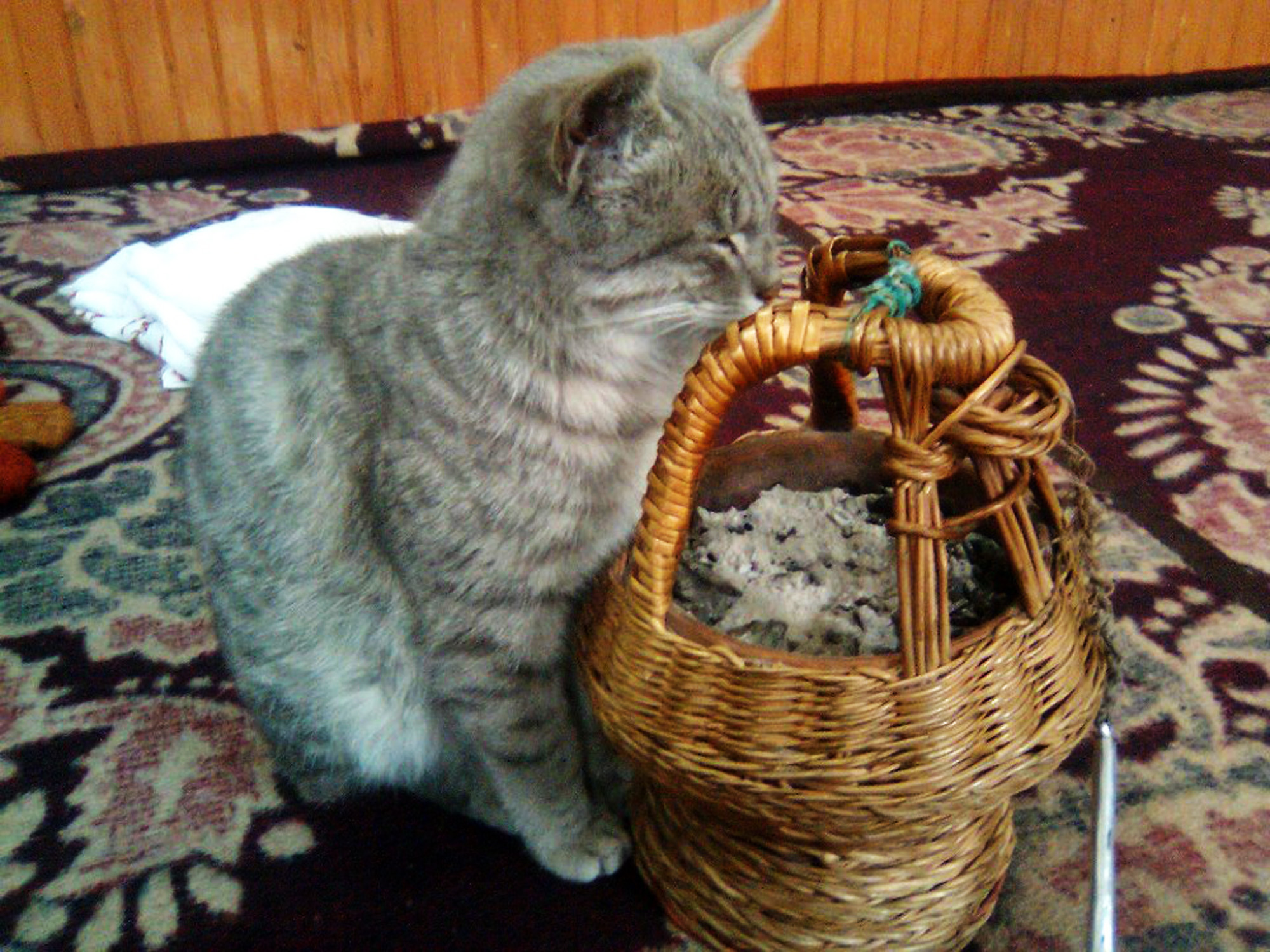
While there are many types of Kangris, their popularity and rates vary, depending on the place from where they are made because each place has carved a niche for itself, and thus a reputation.
“Those made in Bandipora are particularly famous for their sturdiness and strength while those made in the historical Charar-i-Sharief town are known for their design,” Malla said.
While the average Kangri in the market costs about Rs 150, those made in Charar cost upwards of Rs 1500. “There are even costlier ones, such as those made in Pakharpora and Garen cost even Rs 4000-5000 apiece.”
A lot of changes have taken place in the way the Kangri was being marketed. Not long ago, the Kangri makers would roam around in the periphery of Kashmir and sell it, in barter with the paddy. It usually was happening during the days after harvesting. The key factor for the barter was that the weavers were usually without lands and they would secure their food requirements in exchange for the firepots.
That system has completely changed. Now people in urban and rural Kashmir purchase Kangris in cash.
Not Threatened
Although an essential part of Kashmiri culture, the wicker craft has also diversified and is gaining prominence in the export market. It is probably the only handicraft, which does not face competition by machine-based production like other handicrafts whose production has been under constant threat due to the mechanical interventions. However, the sellers and the weavers alike believe sales have dwindled although not to the extent as other crafts.
Despite modern gadgetry having become mainstream particularly in the urban set-up, the flame of Kangris is still warm. A sizable section of people still prefers to buy Kangris owing to the non-dependable and inconsistent electricity supply during winters.
The wicker craft, however, is a male-dominated industry. Although women do work, the bulk of the workforce comprises men. The participation of women in craft-making varies from place to place and area to area.
Kangri Cancer
The warm companion for winters however has its costs also. Kangri Cancer, a type of skin cancer endemic to Kashmir is caused due to constant irritation caused by Kangri due to it being constantly close to the abdomen under the Pheran during winters. It mainly affects the abdominal region, inner thighs and legs.
William Elmslie first documented the squamous carcinoma of the skin among Kashmiris and ascribed it to the use of Kangri. These findings were then confirmed by Theodore Maxwell which were followed by a larger series by Neve brothers, Dr Arthur Neve and Ernest Neve at Christian Missionary Hospital, Srinagar.
Among 5080 patients seen by Dr Elmslie, in the 1866 paper, Etiology of epithelioma, published in Indian Medical Gazette, 30 that means 1 in every 240 had Kangri cancer. Of the 2491 surgeries conducted for epithelioma between 1881 to 1923, about 2000 (80 per cent) were done for Kangri Cancer. The cases were normally reported among the ill-clad sections of society who had no means other than the Kangri to fight the cold. However, the incidences of Kangri cancer are now on the decline.
Registered Artisans
Despite being a mainstay of the rural economy, only 1000 artisans are registered with the Handicraft Department. “We have 1000 willow wicker artisans registered with us,” said Mahmood Ahmad Shah, Director Handicrafts and Handlooms. He, however, said they don’t have the data available on the annual turnover of this small cottage industry.
The Khadi Village and Industry Board (KVIB) on the other hand said that they have helped some of the artisans with financial interventions, majorly in the Ganderbal district. An official, Ahmadullah Sheikh posted at the Ganderbal Office of the KVIB said that for the 2021-22 fiscal they have sponsored 26 cases of willow wicker artisans. “The project cost is 1.37 crores with a margin (subsidy) of 47.95 lakh rupees.”
The figures for other main areas could not be fetched. Notably, the most willow wicker artisans are from Ganderbal, as per the Khadi Village and Industry Board officials.
















This is called the actual mean of Journalism……
By this type of cover …..we got to know all about Kashmiri Kangri .
Hats off Minhaj